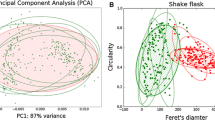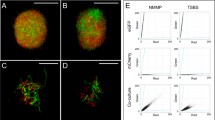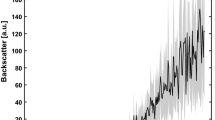Abstract
The effects of varying inoculum age and production scale upon the morphology and viability of Streptomyces clavuligerus were studied by analyzing visible and fluorescent light images acquired throughout pilot-plant and pre-industrial scale fermentations. Changes in production scale reveal that in 5 m3 fermentors, the maximum hyphal area obtained is double the value obtained in 0.5 m3 fermentors. It is probably due to the higher shear stresses acting upon hyphae in the 0.5 m3 fermentor caused by higher tip speeds observed in these. The morphological quantification based on elongation and branching rates allowed fermentations to be pattern classified into distinct physiological time zones namely elongation, branching, fragmentation, etc. The general pattern observed for fermentations inoculated with late exponential phase inocula was similar to the pattern of fermentations run with stationary phase inocula except that both the elongation and branching periods started earlier in the former case. Using the available staining technique and image acquisition system, the viability seemed to be generally high and constant throughout the time course of all the studied fermentations.





Similar content being viewed by others
References
Metz B, Kossen NWF (1977) The growth of moulds in the form of pellets—a literature review. Biotech Bioeng 19:781–799
Krabben P, Nielsen J (1998) Modelling the mycelial morphology of Penicillium species in submerged cultures. Adv Biochem Eng/Biotechnol 60:125–152
Metz B, Kossen NWF, van Suijdam LC (1979) The rheology of mould suspensions. Adv Biochem Eng 11:104–156
Whitaker A, Long PA (1973) Fungal pelleting. Process Biochem 11:27–31
Vecht-Lifshitz SE, Magdassi S, Braun S (1990) Pellet formation and cellular aggregation in S. tendae. Biotechnol Bioeng 35:890–896
Schügerl K, Wittler R, Lorenz T (1983) The use of molds in pellet form. Trends Biotechnol 1:10–123
Davey HM, Kell DB (1996) Flow cytometry and cell sorting of heterogeneous microbiological populations: The importance of single cell analysis. Microbiol Rev 12:641–696
Virta M, Lineri S, Kankaanpää P, Karp M, Peltonen K, Nuutila J, Lilius E (1998) Determination of compliment-mediated killing of bacteria by viability staining and bioluminescence. App Environ Microbiol 2:515–519
Adams HL, Thomas CR (1988) The use of image analysis for morphological measurements on filamentous organisms. Biotechnol Bioeng 32:707–712
Packer HL, Thomas CR (1990) Morphological measurements on filamentous microorganisms by fully automatic image analysis. Biotechnol Bioeng 35:870–881
Tucker KG, Kelly T, Delgrazia P, Thomas CR (1992) Fully automatic measurements of mycelial morphology by image analysis. Biotechnol Prog 8:353–359
Cox PW, Thomas CR (1992) Classification and measurement of fungal pellets by automated image analysis. Biotechnol Bioeng 39:945–952
Reichl U, King R, Gilles ED (1992) Characterisation of pellet morphology during submerged growth of Streptomyces tendae by image analysis. Biotechnol Bioeng 39:164–170
Drouin JF, Louvel L, Vanhoutte B, Vivier H, Pons MN, Germain P (1997) Quantitative characterisation of cellular differentiation of Streptomyces ambofaciens in submerged culture by image analysis. Biotechnol Tech 11:819–824
Mauss P, Drouin JF, Pons MN, Vivier H, Germain P, Louvel L, Vanhoutte B (1997) Location of respiration activity in filamentous bacteria by image analysis. Biotechnol Tech 11:813–817
Belmar-Beiny MT, Thomas CR (1991) Morphology and clavulanic acid production of Streptomyces clavuligerus: Effect of stirrer speed in batch fermentations. Biotechnol Bioeng 37:456–462
Braun S, Vecht-Lifshitz SE (1991) Mycelial morphology and metabolite production. Trends Biotechnol 9:63–68
Paul GC, Priede MA, Thomas CR (1999) Relationship between morphology and citric acid production in submerged Aspergillus niger fermentations. Biochem Eng J 3:121–129
Okada S, Iwamatu S (1997) Scaleup production of milbemycin by Streptomyces hydroscopicus subspecies Aureolacrimosus with control of internal pressure, temperature, aeration and agitation. J Chem Technol Biotechnol 70:179–187
Neves AA, Vieira LM, Menezes JC (2001) Effects of preculture variability on clavulanic acid fermentation. Biotechnol Bioeng 72:628–633
Roubos JA, Krabben P, Luiten RGM, Verbruggen HB, Heijnen JJ (2001) A quantitative approach to characterizing cell lysis by mechanical agitation of Streptomyces clavuligerus. Biotechnol Prog 17:336–347
Li ZJ, Shukla V, Wenger K, Fordyce A, Pedersen AG, Marten M (2002) Estimation of hyphal tensile strength in production-scale Aspergillus oryzae fungal fermentations. Biotechnol Bioteng 77:601–613
Li ZJ, Bhargawa S, Marten MR (2002) Measurements of the fragmentation rate constant imply that the tensile strength of fungal hyphae can change significantly during growth. Biotechnol Lett 24:1–7
Sebastine IM, Stocks SM, Cox PW, Thomas CR (1999) Characterisation of percent viability of Streptomyces clavuligerus using image analysis. Biotechnol Tech 13:419–423
Stocks SM, Thomas CR (2001) Viability, strength and fragmentation of Saccharopolyspora erythrea in submerged fermentation. Biotechnol Bioeng 75:702–709
Neves AA, Pereira DI, Vieira LM, Menezes JC (2000) Real time monitoring biomass concentration in Streptomyces clavuligerus cultivations with industrial media using a capacitance probe. J Biotechnol 84:45–52
Andersson LC, Strandberg L, Enfors S (1996) Cell segregation and lysis have profound effects on growth of Escherichia coli in high cell density fed batch cultures. Biotechnol Prog 12:190–195
Pons MN, Drouin JF, Louvel L, Vanhoutte B, Vivier H, Germain P (1998) Physiological investigations by image analysis. J Biotechnol 65:3–14
Bhargava S, Wenger K, Marten MR (2003) Pulse addition of limiting-carbon during Aspergillus oryzae fermentation leads to improved productivity of a recombinant enzyme. Biotechnol Bioeng 82:111–117
Acknowledgements
This work was partially financed by the PRAXIS XXI program. LSP acknowledges Fundação para a Ciência e a Tecnologia for their research grant under PRAXIS XXI program (FCT-BM/98/15210), The French Embassy and The British and The Portuguese (ICCTI) Research Councils for financing stays in LSGC-CNRS, France and in Prof. C. Thomas’ (Birmingham University, UK) lab. The authors wish to express their gratitude to CIPAN S.A. for partially financing the project and for permission to publish the above results. The authors thank Prof. Muge and co-workers at the Materials Department at I.S.T for contributing one of the image analysis algorithms.
Author information
Authors and Affiliations
Corresponding author
Additional information
An erratum to this article can be found at http://dx.doi.org/10.1007/s00449-004-0362-4
Rights and permissions
About this article
Cite this article
Pinto, L.S., Vieira, L.M., Pons, M.N. et al. Morphology and viability analysis of Streptomyces clavuligerus in industrial cultivation systems. Bioprocess Biosyst Eng 26, 177–184 (2004). https://doi.org/10.1007/s00449-003-0349-6
Received:
Accepted:
Published:
Issue Date:
DOI: https://doi.org/10.1007/s00449-003-0349-6




